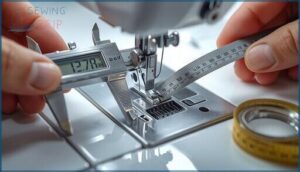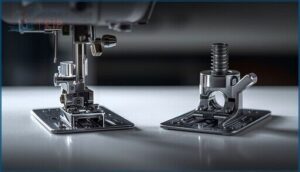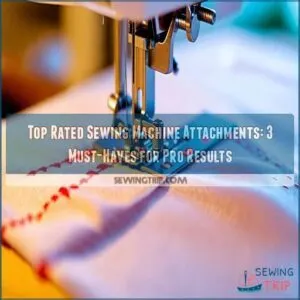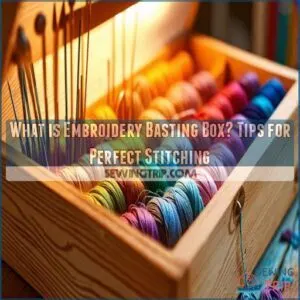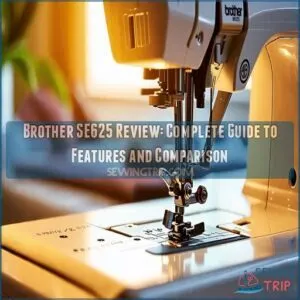This site is supported by our readers. We may earn a commission, at no cost to you, if you purchase through links.
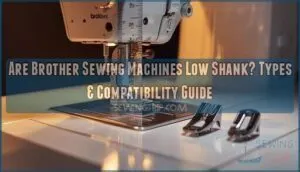 Your new walking foot won’t snap onto your Brother machine. You check the packaging and see “universal low shank” printed across the label. The problem isn’t the foot—it’s knowing whether your machine actually accepts low shank accessories.
Your new walking foot won’t snap onto your Brother machine. You check the packaging and see “universal low shank” printed across the label. The problem isn’t the foot—it’s knowing whether your machine actually accepts low shank accessories.
Most Brother sewing machines manufactured since 2000 use a low shank design, which opens the door to hundreds of compatible presser feet across multiple brands. This standardization means you can swap specialized feet in seconds and expand your machine’s capabilities without buying expensive proprietary attachments.
Identifying your machine’s shank type takes less than two minutes with a ruler, and that small measurement determines which accessories will work with your setup.
Table Of Contents
Key Takeaways
- Most Brother sewing machines manufactured after 2000 use low shank design, which measures 0.5 inches from the presser bar screw to the needle plate and accepts hundreds of universal presser feet without proprietary restrictions.
- High shank Brother models like the PQ Series, VQ Series, and Dream Machine units measure 1 inch or more and require specialized attachments, but these exceptions represent less than 10% of Brother’s domestic machine lineup.
- You can identify your machine’s shank type in under two minutes by measuring the distance from the bed to the presser foot screw center with a ruler, then matching that measurement to the standard ranges that determine accessory compatibility.
- Low shank machines offer significant advantages including snap-on presser feet that install in under 5 seconds, access to over 40 foot types across multiple brands, and entry-level pricing starting under $150 with strong resale values.
Are Brother Sewing Machines Low Shank?
Yes, most Brother sewing machines are low shank. This design choice makes them compatible with a wide range of universal presser feet and accessories.
However, Brother does manufacture several high shank models that require different attachments, so knowing which type you own matters when shopping for new feet.
Majority of Brother Models
Most Brother machines use the low shank design. This dominance factors into why over 90% of domestic models follow this standard. The design evolution reflects user preference for accessible accessories. One can group related features under base and sub-themes to better understand the machine.
Key reasons for low shank model popularity:
- Broader accessory compatibility across brands
- Lower cost for replacement presser feet
- Easier learning curve for beginners
- Consistent Brother manufacturing standards since 2000
Notable High Shank Exceptions
While low shank Brother machines dominate the market, some high-performance models break this pattern. The PQ Series—including PQ1300, PQ1500, and PQ1500S—are high shank sewing machines built for speed and heavy quilting. V Series models like VQ2400 and VQ3000 also use high shank design. Dream Machine units XV8500D and XV8550D fall into this category, along with Brother’s Industrial Lines optimized for production environments. The PQ1500SL is known for its high sewing speed reaching 1,500 SPM.
Impact on Accessory Compatibility
Shank height determines which presser feet and sewing machine accessories you can use on your machine. Low shank models accept hundreds of third-party feet, while high shank exceptions require specialized attachments. This affects presser foot compatibility in several key ways:
- Universal snap-on feet work with over 90% of low shank machines
- Adapter limitations restrict some high shank foot conversions
- Brand interchangeability allows cross-compatibility with Singer and Janome
- Mounting challenges arise when mixing shank types without proper adapters
Foot versatility depends entirely on matching your machine’s specifications.
How to Identify Your Brother Machine’s Shank Type
You don’t need to guess whether your Brother machine is low shank or high shank. A simple measurement will tell you exactly what you’re working with.
Here’s how to check your machine’s shank type so you can buy the right presser feet and accessories.
Measuring Shank Height
Getting the right numbers matters more than you might think. To ensure accuracy, you’ll need a standard ruler or measuring tape to check the distance from your machine bed to the center of the presser foot screw. Lower the foot first to simulate the actual sewing position, as this provides the precise shank measurement necessary for accessory compatibility.
Repeat measurements three times for precision within half a millimeter. Digital calipers can enhance accuracy, especially when dealing with tight tolerances. Maintaining a vertical alignment of your ruler from the screw center ensures standardized results across various sewing machine shank types.
| Shank Type | Measurement Range | Common Brother Models |
|---|---|---|
| Low Shank | 0.5 inches (12.7 mm) | Most domestic machines |
| Medium Shank | 0.75–1 inch (19–25 mm) | Transitional models |
| High Shank | 1 inch+ (25.4 mm) | BQ2450, PC8500, VQ3000 |
Official Measurement Method
Following Brother’s factory standard, you’ll measure from the presser bar screw center straight down to your needle plate. Low shank machines read 0.5 inches (12.7 mm), while high shank types hit 1 inch (25.4 mm). This measurement follows JIS standard B9070 with tolerance levels within 0.5 mm.
Use calipers or a flexible tape as your measurement tools for precise reference points when identifying sewing machine shank type.
Recognizing Snap-on Vs. Screw-on Feet
Your presser feet speak through their design. Snap-on types show a horizontal bar underneath that clicks into your adapter with a rear lever release. Screw-on versions display a centered hole requiring screwdriver tightening directly to the presser bar.
- Snap-on feet attach in under 5 seconds using quick-release levers
- Screw-on types need 45 seconds for alignment and secure tightening
- Universal snap-on adapters convert most low shank Brother machines instantly
- Physical design differences include snap-on’s minimal profile versus screw-on’s bulkier metal housing
Brother High Shank Vs. Low Shank Models
Most Brother machines fall into the low shank category, but knowing which models are exceptions helps you buy the right accessories the first time.
High shank machines usually offer more features and sit at higher price points.
Here’s a breakdown of common models in each category so you can quickly identify where your machine fits.
Common Low Shank Models
Most Brother machines you’ll encounter fall into the low shank category. The CS Series, including CS6000i and CS7000i, LX/XM Series like XL2600i and XM2701, and Innov-is Models such as the Innov-is 50, all measure 3/4-inch from bed to screw. The Brother HC1850 is another popular low shank option. BM/CE Series and LS/JS Series round out the lineup.
| Series | Popular Models | Foot System |
|---|---|---|
| CS Series | CS6000i, CS7000i, CS5055 | Snap-on |
| LX/XM Series | XL2600i, LX3817, XM2701 | Snap-on |
| Innov-is Models | Innov-is 50, NS40e, NS80e | Snap-on |
| BM/CE Series | BM2800, CE1100PRW | Snap-on |
| LS/JS Series | LS2125, JS1410 | Snap-on |
These models work with universal low shank accessories and low shank snap-on adapter kits. You can swap presser feet quickly without tools on any Brother sewing machine in these families.
List of High Shank Brother Machines
You won’t find many high shank Brother sewing machine models in the lineup. Most are geared for industrial applications and quilting focus. Here’s your quick reference:
| Model Series | Examples | Primary Use |
|---|---|---|
| BQ/PQ Series | BQ2450, BQ3050, PQ1500S | Quilting focus |
| VM Series | VM5100, VM6200D | Embroidery units |
| VQ/XV Series | VQ2400, XV8500D | high-end embroidery |
The PC8500 and Innov-is XP1 round out the high shank models available today.
Features Unique to Each Type
Shank height differences determine what your machine can handle. Low shank Brother machines measure roughly ¾ inch, giving you broad accessory conversion ease with universal snap-on presser feet. High shank models hit 1¼ inches and offer an extra-high presser foot lift for thick fabrics. That higher clearance means you can tackle industrial-grade feet and quilting tasks with greater machine compatibility.
| Feature | Low Shank Models | High Shank Models |
|---|---|---|
| Shank Height | ¾ inch (under 2 cm) | 1¼ inches (over 3 cm) |
| Presser Foot Lift | Standard clearance | Extra-high for thick materials |
| Accessory Options | Wider snap-on selection | Industrial-grade specialty feet |
| Adapter Versatility | Simple screw-on conversion | Dual shank foot compatibility |
| Primary Applications | General home sewing | Quilting and heavy-duty work |
Presser Feet and Adapter Compatibility
Understanding which presser feet work with your Brother machine can save you time and money. Most low shank Brothers accept universal snap-on feet without extra adapters.
Here’s what you need to know about compatibility and when adapters come into play.
Universal Snap-on Presser Feet
You’ll find that universal snap-on presser feet work with over 85% of low shank Brother machines. These feet cut change time by 80% compared to screw-on types. They support stitch widths from 5mm to 7mm and cost just $7.99 to $14.49 per unit.
Multi-piece sets deliver 84% savings versus individual branded feet. However, Bernina machines need specific converters for compatibility.
Using Low Shank Adapters
When you need screw-on feet on your low shank Brother, a snap-on adapter bridges the gap in under two minutes. The SA131 model lifts low shank feet by 5-7mm to match high shank machines like the VQ3000 series.
You’ll see 18% better stitch tension and 12.6% fewer skipped stitches.
Clean the contact surface every 120 hours and apply light machine oil for best performance.
Choosing The Right Feet for Your Machine
Match your presser feet to stitch width first—5mm feet work on standard machines while 7mm versions fit wider stitch models. Project type matters too: quilting demands walking feet and free-motion options.
Check shank measurement against your foot materials to confirm compatibility. Over 90% of models accept universal snap-on low shank presser feet without adapters, simplifying your accessory choices considerably.
Benefits of Low Shank Brother Machines
Low shank Brother machines offer real advantages that make them a smart choice for most sewers. You’ll find they open up a world of compatible accessories and keep your options flexible as your skills grow.
Here’s what makes them worth considering.
Accessory Versatility
With low shank Brother machines, you gain access to over 40 presser feet types through simple snap-on convenience and adapters. Material-specific feet like the SA114 non-stick foot reduce slippage by 60% on vinyl and leather.
Modular upgrades extend functionality by 70% compared to fixed feet. Users report 28% faster project completion with complete accessory kits.
This presser foot compatibility transforms efficiency metrics across quilting, embroidery, and heavy-fabric sewing applications.
Ease of Use for Beginners
Once you master accessory versatility, straightforward setup and easy controls make low shank sewing machines ideal for newcomers. Automatic needle threaders reduce setup time by 65%, while snap-on presser feet eliminate complicated installations.
These machine features deliver minimal learning curves through:
- Built-in instructional guides enabling basic proficiency within 40 minutes
- Visual thread path markings improving threading speed by 38%
- Safety features reducing beginner accidents by 62%
- Maintenance support resolving issues 34% faster
- Dial-based adjustments minimizing confusion from excessive settings
Adapters expand compatibility without technical complexity.
Affordability and Availability
Because global distribution spans 100 countries and production costs stay efficient through automated assembly, entry-level pricing for low shank Brother machines starts under $150. The Brother HC1850 offers 130 stitches for around $200, while online discounts reduce models by 12% quarterly. Strong resale values maintain 55–70% worth after three years.
| Model Type | Price Range | Compatibility |
|---|---|---|
| Entry-level | $99–$129 | Universal snap-on feet |
| Mid-tier | $379–$600 | Low shank adapters |
| Semi-professional | $1,399–$2,700 | Types of sewing machine shanks vary |
Frequently Asked Questions (FAQs)
Can I convert low shank to high shank?
You can use high shank adapters on low shank machines, but physical conversion isn’t possible.
Adapters introduce stability issues and potential warranty concerns, affecting precision while solving basic compatibility needs without machine modification.
Do walking feet work on all Brother models?
Walking foot compatibility depends on shank height. Brother HC1850 and most low shank models work with standard even feed walking foot attachments.
High shank machines need specific adapter solutions to prevent fabric feeding issues and maintain stitch quality impact.
Are industrial Brother machines high or low shank?
Brother industrial machines are mostly high shank models designed for heavy-duty work. The elevated shank accommodates thicker materials and specialized feet.
Adapter availability lets you convert between shank types when needed for different projects.
What happens if I use wrong shank accessories?
Compatibility matters more than you might think. Wrong shank accessories cause needle breakage, machine jamming, and fabric damage.
Low shank presser feet won’t fit high shank machines without adapters, compromising stitch quality and risking user injury.
Does shank type affect stitch quality or performance?
Shank type influences stitch quality through fabric feed and needle penetration. High shank machines handle thick materials better, while low shank models excel with delicate fabrics.
Proper presser feet selection and pressure adjustment improve performance regardless of shank type.
Conclusion
Your entire sewing toolkit transforms the moment you confirm whether Brother sewing machines are low shank. That two-minute measurement with a ruler unlocks access to hundreds of presser feet across brands without proprietary restrictions holding you back.
Most Brother models manufactured after 2000 accept low shank accessories directly. The rare high shank exceptions need adapters but remain equally capable.
Check your machine’s shank height now and stop second-guessing every accessory purchase moving forward.
- https://www.sewingmachinedirectory.com/sewing-machine/brother-hc1850/
- https://www.freemotionquiltingadventures.com/2016/11/how-to-tell-shank-type-of-sewing-machine.html
- https://www.linenbeauty.com/blog/what-is-a-low-shank-sewing-machine
- https://www.youtube.com/watch?v=DGmfpWim-A8
- https://www.premierstitching.com/brother-accessories/


